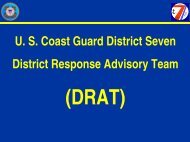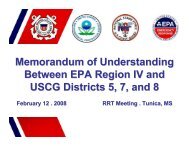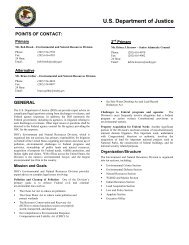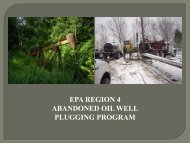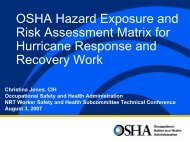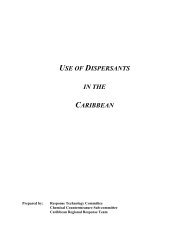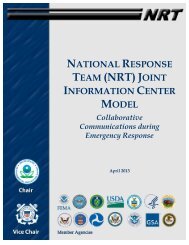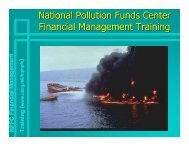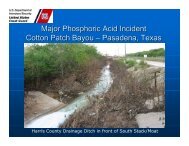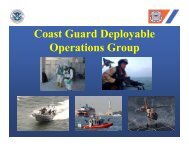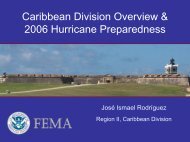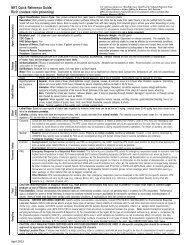Radiological Dispersion Devices (RDD) - U.S. National Response ...
Radiological Dispersion Devices (RDD) - U.S. National Response ...
Radiological Dispersion Devices (RDD) - U.S. National Response ...
Create successful ePaper yourself
Turn your PDF publications into a flip-book with our unique Google optimized e-Paper software.
Field DetectionPersonal SafetyEffect LevelsHealthEffectsCharacteristicsNRT Quick Reference Guide:<strong>Radiological</strong> <strong>Dispersion</strong> Device (<strong>RDD</strong>) 11 For references please see Key References Cited/Used in <strong>National</strong> <strong>Response</strong> Team(NRT) Quick Reference Guide (QRG) for <strong>Radiological</strong> WMD. QRGs are intended forFederal On-Scene Coordinators (OSCs) and Remedial Program Managers (RPMs).Agent: <strong>Radiological</strong> WMDType: <strong>RDD</strong>Description: Any device that causes the purposeful dissemination of radioactive material without a nuclear detonation. Methods of dispersal can include any passive or activedeposition of unsealed radioactive material in the form of liquid, solid, aerosol, or gas into the environment including air, water, soil, or food supply of a population. These devicescan affect a range of populations from very small to very large depending on the dispersal potential of the device. <strong>Devices</strong> may include but are not limited to explosive devices (DirtyBomb), crop dusting aircraft, drinking water treatment facilities, HVAC systems, etc. Typical radionuclides include Americium 241, Californium 252, Cesium 137, Cobalt 60, Iridium192, Plutonium 238, Polonium 210, Radium 226, and Strontium 90.Note: This list of dispersal devices & radionuclides is comprehensive BUT not all inclusive!Alpha Radiation Beta Radiation Gamma RadiationHeavy, charged particle (Helium nucleus, 2 protons A light, sub-atomic particle (electron).Electromagnetic radiation (like visible light).& 2 neutrons).Travels only a few inches in air; can’t penetratehuman skin or clothing; thin paper or dust canprevent its detection.Travels several feet in air; can penetrate human skin &clothing; in human tissue travels < 1/8 inch; plastics &other lightweight materials prevent its detection.Travels many feet in air; can penetrate many inches inhuman tissue & most materials; materials like thickconcrete, steel & lead prevent its detection.Harmful if inhaled or swallowed; not an externalhazard.Harmful if inhaled/swallowed; not external hazard exceptto skin/eyes.Harmful if inhaled/swallowed; is an external hazard even atseveral feet from the source.HALF-LIFE: Rad materials decay by releasing alpha, beta or gamma radiation energy. If half-life of material is >100s of years, radiations may not be “seen” over shortmeasurement times. Each isotope has its own half-life.OnsetHealth effects from radiation exposures greater than 100-200 rem are described by Acute Radiation Syndrome (ARS). Onset of ARS ("prodromal" phase) isindicated first by vomiting, fever, & soon followed by diarrhea & headache, all usually within hours of exposure. If symptoms are more severe & appear rapidly -indicates higher doses & more serious injury. There is significant individual variability of these symptoms but, life-threatening exposures will always present withthese four symptoms.CAUTION: Doses are for healthy adult worker & don’t apply to children or declared pregnant workers.Lowest Dose with Observable effects:Short-Term Whole-Body Dose aShort-Term Symptoms (nausea & vomiting within 4 hrs)100 rad (1 Gy) 5 – 30 (%)Lethality:Short-Term Whole-Body Dose aDeath b from Short-Term Radiation Exposure w/outMedical TreatmentDeath from Short-Term Radiation Exposure withMedical Treatment200 (2 Gy) 5 (%) 90 (%)aShort-term refers to the radiation exposure during the initial response to the incident. The short-term effects listed are likely to be reduced by about one-half if radiation exposureoccurs over weeks.bShort-term deaths are likely to occur from 30 to 180 days after exposure and few if any after that time. Estimates are for healthy adults. Individuals with combined insult of injuryand dose maybe at greater risk.RULES OF THUMB: Unless performing lifesaving or critical operations, If no site specific rad H&S guidance is available & any instrument displays > 2mR/hr, back away,secure area & seek rad H&S input.In all radiation responses: Decrease exposure time & frequency & increase distance & shieldingDosimetry Real time or self-reading dosimeter in addition to a dose of record dosimeter, like a Thermoluminescent Dosimeter (TLD) or Optically Stimulated Luminescent(OSL), should be worn at all times.PPECAUTION: Regardless of PPE used, include dosimetry.Emergency Responders: Wear PPE as designated by site conditions or HASP & record levels worn. PPE Levels, based on scenario risks - from highest level ofprotection to least are: 1) Level A protective suit with pressure-demand Self Contained Breathing Apparatus (SCBA), when: a) event is uncontrolled, b) the type(s)of airborne agent(s) is unknown, c) the disbursal method is unknown, d) disbursal is still occurring or, e) disbursal has stopped, but no information on duration ofthe disbursal of radioactive material, or what the exposure/dose rate may be. 2) Level B protective suit with Pressure-demand SCBA, when: a) <strong>RDD</strong> release iscontrolled or other conditions present a splash hazard. 3) Level C protection with full face-piece respirator with P100 filter or PAPR with HEPA filters when there isa risk of airborne contamination. 4) Level D protection when site conditions permit minimum protection and no airborne radioactivity is present.Emergency Workers: PPE recommendations for other than emergency responders must be developed for site specific conditions in the HASP. PPE will vary byjob type (e.g., cleanup, decon), type of exposure (e.g., airborne or surface/liquid/soil hazard), & other site hazards (e.g., chemical, physical).Medical Baseline: Annual physical & respiratory function exams.During Incident: Conduct medical monitoring pre-entry and post exit from Control Zone.Post Incident: Monitor for signs/symptoms & seek medical attention, if necessary, ASAP. Treatment post exposure will depend on exposure pathway (e.g., internalv. external), amount of dose received and isotope(s) involved.First Aid NOTE: COMMENCE LIFESAVING OR NECESSARY TREATMENT PRIOR TO PATIENT DECONIf signs/symptoms of illness occur, ensure medical attention is provided ASAP. Remove to nearest medical facility IF ANY ONE of the following exists: If on-sitedecon is unsuccessful OR If a dose of > 200 rem is likely OR If serious injury is present.Field Air Sampling: Use a Hi-Vol air pump > 10 cfm (e.g. RADECO 810) with a 4" diameter cellulose filter. For ER sampling, a 10 minute "grab" sample is obtained at 35 cfm (i.e.,10,000 m 3 total). The sample count results can be used for respiratory protection determination by comparing filter count data against the Annual Limits on Intake (ALIs) & DerivedAir Concentrations (DACs) tables for occupational workers in 10CFR20, Appendix B. If sampling for radioiodine, a Lo-Vol < 10 cfm w/filter and silver zeolite cartridge is typicallyused. (Note: Lo-Vols are large, require hours of run-time, and are not typically used for general rad ER work.)Continuous Air Monitoring (e.g., ECAMS) devices provide real time contaminant air concentration or filter samples for analysis. Flow rates, volumes and sampling times for alldevices are set to ensure enough dust & particulates are collected to be able to determine the airborne radioactivity concentration. Many state programs have air sampling programswhose data can provide background radiation air concentration info. This internet site http://www.crcpd.org/Map/RCPmap.htm provides state rad program info. EPA operatesRADNET, a national monitoring system for air, drinking water, precipitation & milk in various cities & monitors real time gamma radiation levels. EPA data can be accessed bycontacting EPA's HQ EOC at 202-564-3850.Air Sample Analysis: When sampling, the filters collect dust & particulates with radioactive material attached. The radioactivity on the filters can be counted using a handheldinstrument (e.g., Geiger-Mueller pancake probe) or portable drawer counter (e.g., Ludlum 2929 or 3030) or sent to a lab. CAUTION: Short Lived Natural Radon Decay Productsmay cause high counts on filters that are counted immediately after sampling. Don appropriate respiratory protection based on initial count as compared to ALI/DACTables as per Health Physics support. Filters should be recounted a minimum of 4 hours later to allow for Radon Products to decay. Resultant activity can be assumedto be contaminant of interest. Respiratory Protection may be reduced based on recounted filters as per Health Physics support advisement.December 2012Final
Waste ManagementDecontamination/CleanuplaboratoryAnalysisSamplingPortable Field Instruments: When looking for radioactive material in particulate form (either alpha, beta, and/or gamma), the <strong>National</strong> Buy lists Ludlum 2241-2 meter with: 1) 44-9for performing contamination surveys on surfaces with alpha, beta, and/or gamma, 2) 44-10 for low energy gamma radiation, 3) 43-68 for alpha and/or beta radiation, or 4) 43-90 foralpha only. If alpha and/or beta radioactive materials are found on a smooth, flat surface, the 239-1F floor monitor could be used. A Ludlum 15 contains two separate probes thatcan measure alpha, beta, and gamma on one probe and fast and thermal neutrons on the other probe. If 2” swipes and/or air filters are collected, the media can be counted using aLudlum 3030 swipe counter. For identification/quantification of alpha, beta, gamma, and/or neutrons, a SAM 940 or SAM 935 can be used but may require advanced training priorto use due to complexity of menus and interpretation of spectrum. For initial entry to determine exposure/dose rate measurements, Ludlum 192 can be used to determine low levelgamma radiation for turn back limits. If going into a high exposure/dose rate area > 1mR/hr, the field team member must use high range instrument such as the RO-20 or RO-2A.BEFORE OBTAINING SAMPLES: Identify sample transportation requirements. Contact EPA/HQ-EOC (202-564-3850) for info on labs to analyze rad samples. Clearly identify &coordinate with the lab to be used since most labs cannot analyze all types of environmental media. Coordinate with investigative units (e.g., FBI) to ensure sample chain-of-custodyis maintained between groups.Note: Detection/analytical equipment & sampling techniques will be highly site-specific & depend on: 1) the characteristics of the <strong>RDD</strong>; 2) the type of contaminated surfaces (e.g.,porous v. nonporous); 3) the phases/purposes of sampling (initial ID v. post-decon sampling); 4) transportation regulations; 5) the acceptance criteria of the analytical laboratory; &6) the sample decon requirements for the waste disposal facilities to be used.SAMPLE COLLECTION: A sampling plan should be created with Subject Matter Expert (SME) input if available. Initial sampling is conducted to define the affected area,determine if the contamination is airborne, and identify radiation type and radionuclide. Further sampling can focus on determining the amount of contaminant present, once initialresults identify the nuclide.Sampling Location Plans: NARAC will provide a preliminary model of the affected area based upon current weather conditions and source estimations, probably within a couplehours of being notified of the event. As time goes on the accuracy of this model will improve as results from ongoing samples and measurements are incorporated. The modeloutputs can be used to guide the best locations for sampling activities. To determine if the contamination is airborne initially place air samplers close to ground zero and aconsiderable distance downrange. Knowing if the contamination is airborne directly affects PPE selection and should be done first. The perimeter of the affected area can befound using contamination measurements (cpm) taken 1-2 inches from surfaces and dose rate measurements (µR/hr) taken at waist height. If contamination is detected on a swipeor if the meter reads 2-5 times above background, the area is likely contaminated. Water and soil sampling are also conducted to define the affected area, but usually follow air andsurface measurements.All samples should be collected in accordance with appropriate procedures. A field log should also be kept during sampling activities to record time, location, andsample type as these are collected. A consistent sampling ID or numbering scheme should be established before samples are collected. Each sample must be ID’edas they are collected.Types of Samples: Air, water, soil, contaminated surfaces (swipes).Air: See field detection section aboveWater: These are radionuclide specific; follow the SOP for sample collection information. These samples usually require a sample volume of at least 1 gal and may require chemicalpreservation.Soil: Obtain a sample from a non-vegetated area. A 5x5x1 inch deep sample (~ 1 lb) should be carefully placed in a plastic bag (try to keep the soil intact as much as possible).Contaminated Surfaces (Swipe Sampling): Using an appropriate swipe media, gently wipe a 100 cm 2 area with gentle pressure. This can be a (4 by 4 inch square) area of thesurface, or a 1 meter long S pattern the width of the wipe.Sample Packaging & Shipping: Subject to DOT, USPS, OSHA & IATA regulations. Contact the sample-receiving lab for their preservation, packaging, shipping & labelingrequirements.Prior to sending any environmental samples, coordinate and prioritize the samples with the recipient laboratory. The goal of laboratory analysis for environmental samplingis to determine the presence or absence and amount of radioactivity and to identify the nuclide(s). Depending on the location, there may be DOE, State, and Civil Support Teammobile laboratories available and ready to assist near the incident.Laboratory Information: Contact EPA/HQ-EOC (202-564-3850)Caution: Resuspension during response activities, decon and cleanup activities below should be monitored, assessed and addressed, as needed, to protect public and workersafety.Contamination Control: Expedited vehicular decon will limit contaminant migration in support of emergency response, public relocation, mass care decisions and access in &around contaminated zones. Employ tacking agents to mitigate contaminant re-suspension in traffic areas; contain decon water, precipitation & surface water runoff - especially inhigh contamination area(s); perform gross decon of areas of highest contamination; & protect water supplies & treatment facilities.Cleanup Methods: Decon and cleanup methods and technologies decisions are based upon radionuclide, chemical form, activity, dose, substrate, land/property use, and publicand worker exposure and cleanup goals. Radiation cleanup largely relies upon removal of contaminated substrate or material (soil excavation, cement scarification, roof and sidingremoval, building demolition, etc.).Cleanup of Surfaces: (Non-destructive or limited destruction methods). Particulate or liquid HEPA vacuuming when/if appropriate aqueous based washing or other surfacetreatments using chemicals, foam, acids, gels, strippable coating and fixing agents, etc. can reduce but not eliminate radioactivity and are more effective on non-porous surfaces.These surface decon methods can be used: (1) immediately open roadways and other critical infrastructure or key resources like subway stations, hospitals and fire equipment untilmore aggressive decontamination can occur; (2) where low levels exist and only minimal reduction is required; or (3) where there is only very limited long-term exposure like powersubstations.Use of Water: Minimize water usages to the extent practicable because of the difficulty in handling and disposing liquid radioactive waste.(See Waste Management Section below)Contact: For specific details contact the <strong>National</strong> <strong>Response</strong> Center at 1-800-424-8802 and ask for EPA Consequence Management Assistance Team (CMAT).Waste Management – An <strong>RDD</strong> may result in millions of tons of radiological contaminated solids and billions of gallons of radiological contaminated aqueous liquids. Most wastes(95 to 99 + %) will be Class A (the lowest level) low level radiological wastes (LLRW). There will be smaller amounts of Class B or Class C LLRW solid wastes. Commercial facilitiesexist in the U.S. for disposal of LLRW (solid wastes) including Energy Solutions, U.S. Ecology, and Waste Control Specialists. The cost and effort of transport of millions of tons ofClass A LLRW over long distances may be prohibitive. Approval for disposal of lower volumes of Class B & C LLRW facilities needs the cooperation of the states and municipalitiesalong the route. Collection and management of contaminated liquids will be problematic due to the limited storage and treatment capabilities.Waste Segregation and Staging – Initial waste streams will be mostly PPE, clothing and personal items from evacuees, and decon water but cleanup wastes will follow shortly andneed to be segregated. Waste staging areas should be in the contaminated area; out of flood zones; and away from people, CI/KR, and locations targeted for early cleanup. Ifavailable, use land/sea boxes roll-offs, drums, totes, bins, etc. Or, cover with plastic and tarps to keep wastes dry and prevent contaminant spread. Fukushima wastes werecontainerized, placed over a bentonite (to adsorb cesium) and covered with a tarp. Higher activity wastes from the blast zone and areas immediately downwind of the blast zone(high contamination zone or HCZ) should be kept separate, sealed in appropriate containers, and stored in the HCZ. Waste staging and interim storage may continue for some timeawaiting permanent disposal. Immediately begin the following:Waste management planning. Involve state waste management officials and contact EPA’s Office of Resource Conservation and Recovery (ORCR) thru EPA’s EOC(202-564-3850)Minimize aqueous liquid wastes: Caution: Contact the sewage authority before discharging to sanitary sewer. Use the minimum amount of wash down water; consideron-site water treatment technologies; use advanced surface cleaning technologies; and use dry cleanup technologies.Consider permanent “onsite and in-state” solutions for Class A wastes. Most states’ regulations have emergency waste approval and facility permitting provisions.December 2012Final



